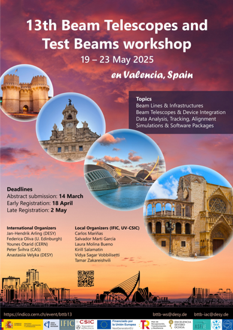Speaker
Description
The upcoming HL-LHC will pose significant challenges to particle detectors which will have to cope with many quasi simultaneous collisions. To disentangle different collisions and to restore the efficiency of reconstruction algorithms, the next-generation of silicon pixel detectors must provide a per hit time measurement with a resolution on the order of 50 ps enabling 4D tracking. 3D silicon sensors, with their vertical electrode configuration penetrating into the substrate, can offer a promising solution for such applications due to their intrinsic radiation hardness and fast charge collection properties.
This work presents a timing performance study of an existing 3D silicon sensor read out by a Timepix4 ASIC, based on data collected from a recent testbeam campaign, using the Timepix4 beam telescope. A comprehensive timing analysis was conducted, incorporating corrections for the time-walk effect and for variations in the Voltage Controlled Oscillator clocks used in the Time-to-Digital converters. To achieve the best timing resolution, correction parameters must be determined and applied for each pixel. The sensor response was examined under both perpendicular and grazing angle incidence of the tracks, with the latter providing insight into the timing behavior at different depths within the sensor. After applying these corrections, a currently best timing resolution of order of 150 ps was achieved for the pixel area between the electrodes. Various studies of the 3D sensor as function of bias voltage and threshold setting will be presented, and the limitations of the tested 3D sensor will be discussed.
These results provide valuable input for the developments for the future LHCb VELO upgrade, where 3D sensors are a prominent candidate for achieving precise timing in such a dense collision environment.
